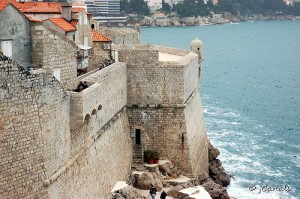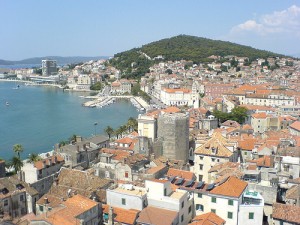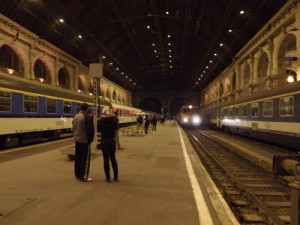 Zagreb is the capital of Croatia , famous for its old city and cobble stones reminding tourists of Prague, Vienna or Budapest. It is also where you’ll most likely arrive if you come from other parts of the world (via a major European hub) or by train from other European cities.
Zagreb is the capital of Croatia , famous for its old city and cobble stones reminding tourists of Prague, Vienna or Budapest. It is also where you’ll most likely arrive if you come from other parts of the world (via a major European hub) or by train from other European cities.
Dubrovnik is located on the Adriatic Sea coast and is one of the most well known tourist resorts in Croatia and Europe. Known as the “Pearl of the Adriatic” , the city has been listed as a UNESCO site since 1979.
Quick summary
There is not train connection between Zagreb and Dubrovnik but bus fares start at about €27* per person one way. Flights take significantly less (just an hour) and start at €41 per person, one way. If you like scenic drives, then part of this route- from Split to Dubrovnik – will make you fall in love with Croatia.
Flights from Zagreb (airport code: ZAG) to Dubrovnik
Zagreb International Airport (ZAG) is located 17 km from the city center, to which is connected by buses. It is the most important airport in Croatia and a hub for Croatia Airlines. It handles flights within Europe, as well as domestic flights.
Dubrovnik airport (DBV) is located about 20 km from the city center and is the third largest airport in Croatia. Dubrovnik Airlines is based here. Most of the flights it serves are seasonal, but there are domestic flights and flights from some European capitals which operate year-round.
Flights between Zagreb and Dubrovnik are operated only by Croatia Airlines. The flight time is 1h 5 min. Regardless of when you fly in 2012, expect to pay from €41 per person one way for a flight between the two cities.
Buses from Zagreb to Dubrovnik
There are 8 buses per day between Zagreb and Dubrovnik , including several night buses. The total journey time is about 11 h. It’s not possible to book the tickets online. You can check the timetable here . Fares start at 205 Croatian kune (about €27) per person, one way and depend on the bus company you choose.
>>read more about Bus Travel in Croatia
Driving from Zagreb to Dubrovnik
You can rent a car in Zagreb and drive the 627 km to Dubrovnik on A1/E71. You should be able to cover the distance in about 7 ½ h but plan some stops along the way. This route also includes a ferry crossing (Trpanj – Ploce).
The route from Split to Dubrovnik is a beautiful scenic journey through various travel destinations and small villages.
Note: *at the time the article was written


 If you’re looking for more than a snack, but not quite a full-blown meal in the center of Zagreb, Mimice (MEE-mee-tseh, meaning ‘things overlooked or hidden’) may be just the place for you. Set into the foundation of Ulica Nikole Jurišića 21, this mom-and-pop fish house is just a few blocks east of the main square. The selection of fried Adriatic fish, potatoes and a few simple vegetable dishes is offered a la carte, which makes the unpretentious hideaway ideal for those who enjoy sampling from one another’s plates. Service is cafeteria-style. Simply walk up to the counter, tell the lady in the hair net what you’d like, then pay for it (in cash) at the cash register.
If you’re looking for more than a snack, but not quite a full-blown meal in the center of Zagreb, Mimice (MEE-mee-tseh, meaning ‘things overlooked or hidden’) may be just the place for you. Set into the foundation of Ulica Nikole Jurišića 21, this mom-and-pop fish house is just a few blocks east of the main square. The selection of fried Adriatic fish, potatoes and a few simple vegetable dishes is offered a la carte, which makes the unpretentious hideaway ideal for those who enjoy sampling from one another’s plates. Service is cafeteria-style. Simply walk up to the counter, tell the lady in the hair net what you’d like, then pay for it (in cash) at the cash register. One of the newest hostels in Zagreb, Fulir Hostel has only been open since 2006. That makes its meteoric rise and its perch atop the hostel market in that city all the more impressive. Ranked at the top of most of the Internet booking websites, Fulir Hostel also has rabid endorsements from travelers and a great looking website to recommend it.
One of the newest hostels in Zagreb, Fulir Hostel has only been open since 2006. That makes its meteoric rise and its perch atop the hostel market in that city all the more impressive. Ranked at the top of most of the Internet booking websites, Fulir Hostel also has rabid endorsements from travelers and a great looking website to recommend it.  Touring
Touring Watch out for the Trams
Watch out for the Trams Describe Croatia and you might come up with adjectives like relaxing, laid-back, chill, even sedate. A typical Croatian vacation consists of hanging out on the beach or people watching in a cafe. But a significant number of people are now turning toward adding thrills to their vacations, and to paintball as a way to get that adrenaline rush.
Describe Croatia and you might come up with adjectives like relaxing, laid-back, chill, even sedate. A typical Croatian vacation consists of hanging out on the beach or people watching in a cafe. But a significant number of people are now turning toward adding thrills to their vacations, and to paintball as a way to get that adrenaline rush.